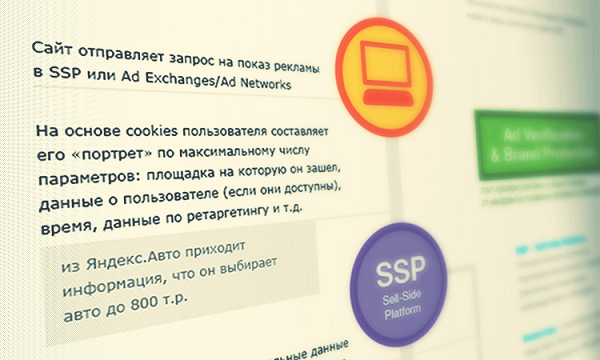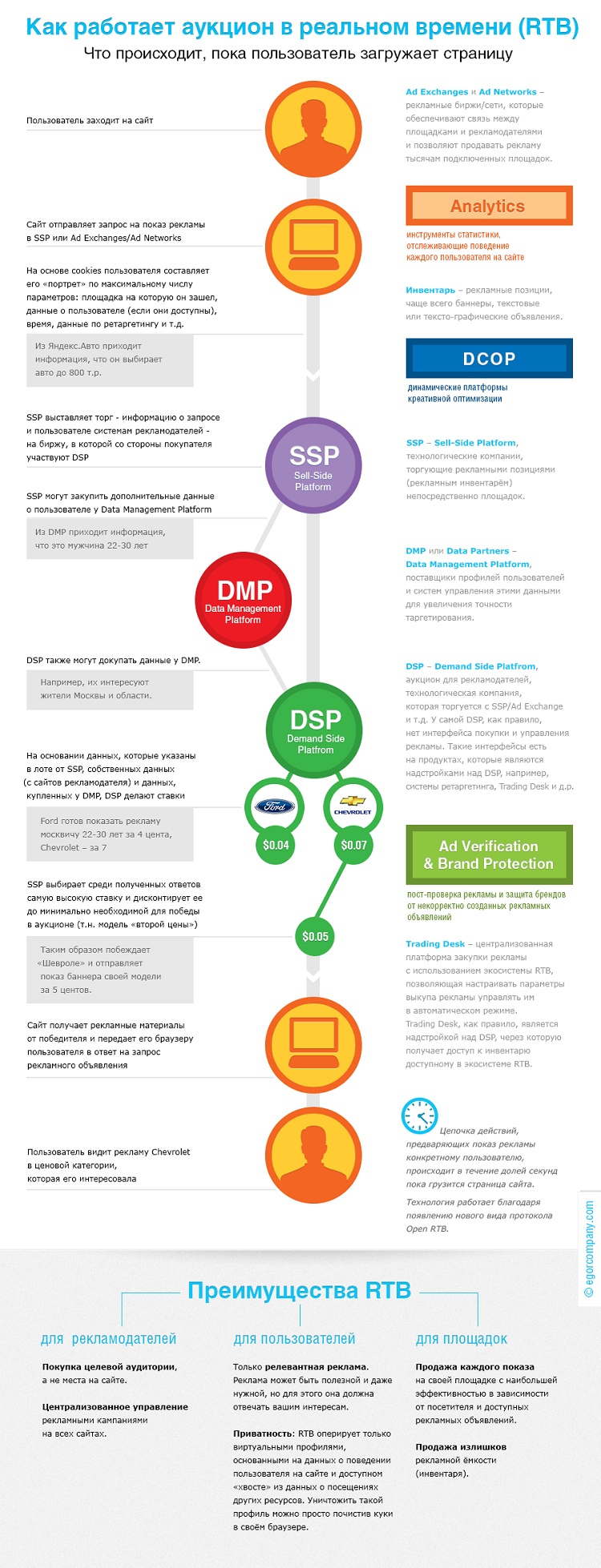What is RTB: New Online Advertising Technologies

Recently in RuNet articles about real-time auction technology - Real-time Bidding (RTB). So far this topic has been discussed more on specialized resources, so I will be one of the first to talk about it on Habré. This is genuine, including technological innovation in the online advertising market, with which it is time to introduce those to whom it is actually aimed: advertisers who buy ads on the Internet, and sites that earn on the sale of display advertising and traffic (Habrahabr.ru , eg :).
According to forecasts, prices for online media advertising in 2013 will increase by 14 percent, while on average advertising will rise in price by 10 percent. Display advertising will overtake other Internet advertising tools as well - for example, contextual advertising will grow by only 13%. In my opinion, RTB will be the driver of this growth.
What is RTB?
In simplified terms, RTB is an exchange on which there are three parties: the advertiser, who decides how much he is willing to pay to show ads to a specific user, the sites that are sold on the basis of an auction in real time, and the user - or rather his anonymized data - right show advertising which is the subject of bargaining. And trading on this exchange takes place in real time: the chain of actions that precede the display of advertising to a specific user occurs within a fraction of a second while the page is loading. During this time, data about the user - the site he visited, information that is known about his site, possibly - additional information from special data providers - is put up for auction, and goes to that advertiser, who chose them for himself as the most relevant and offered the best price. The page loaded - and the owner, say, the iPhone sees an ad for bumpers for him.
Anonymous cookie-related user data includes a significant number of user-related parameters (query history, social data, geography, retargeting data). Thanks to this, the user sees the most targeted advertising for him.
The line between annoying advertising and useful information is very simple: the user perceives it differently as soon as she begins to talk about his real needs. Let's say you often have to read in the comments that users love advertising on Habrahabr. Well, or at least find it useful and often click on it. This is an absolutely normal situation for thematic resources, the audience of which is gathered by understandable interest, which is well known to advertisers. And this is a killer feature of RTB: participation in this system makes any resource thematic.
As a result, this gives an increase in efficiency by orders of magnitude. In traditional display advertising, it is customary to operate with clickthrough rates (CTR) at the level of fractions of a percent. RTB increases the click-through rate to tens of percent, CTR of 15% and higher become a reality.
RTB allows the advertiser to meet exactly with the client that he needs. And users - see ads that interest them. At the same time, user privacy remains out of danger, since, in essence, RTB operates with certain virtual profiles based on data about user behavior on the site and the tail available to it from data on visits to other resources. You can destroy such a profile simply by clearing cookies in your browser.
RTB ecosystem
The hardest part in RTB terminology is to learn the many three-letter combinations that make up the basic concepts in RTB. We’ll take the materials from this article for description :
Demand Side Platfrom (DSP) is an auction for advertisers, a technology company that trades with SSP / Ad Exchange, etc. DSP itself, as a rule, does not have an interface for buying and managing advertising. Such interfaces are on products that are add-ons over DSP, for example, retargeting systems, Trading Desk, etc.
Sell-Side Platform (SSP) - technology companies that sell advertising positions ( advertising inventory ) directly sites.
Ad Exchanges and Ad Networks- advertising exchanges / networks that provide communication between sites and advertisers and allow you to sell ads to thousands of connected sites.
Data Management Platform (DMP or Data Partners) - Providers of user profiles and data management systems to increase targeting accuracy.
Trading Desk is a centralized platform for the purchase of advertising using the RTB ecosystem, which allows you to configure the options for buying an advertisement to manage it automatically. Trading Desk, as a rule, is an add-on over the DSP, through which it gets access to the inventory available in the RTB ecosystem.
DCOP - Dynamic Platforms for Creative Optimization.
Ad Verification & Brand Protection- Post-verification of advertising and protecting brands from incorrectly created advertisements.
Analytics - statistics tools that track the behavior of each user on the site.
How it works
At first there was a text quest with 10 points, but then I decided to make a picture - I hope, this is more clear: the

web version of the picture: egorcompany.com/pages/rtb
To carry out all these operations, a new kind of protocol Open RTB was developed within a fraction of a second .
History of development
View from the advertiser
RTB was the answer to the needs of advertisers:
firstly, the transition from the package purchase model to the purchase of specific impressions. If the quality of traffic on the site decreases or its composition changes, the advertiser will not even notice this, since in any case he buys impressions only to users who are interested in him. Any “left” traffic no longer falls into its “load” as part of a paid package, as is usually the case. In fact, advertisers buy their target audience, and not a place on the site.
Secondly,a “second price” system that optimizes advertising costs. Bidding is carried out in increments of 1 cent and if you indicate a cost per impression of 11 cents, and your competitor - 9, then you win the auction, but your bid is automatically discounted to a minimum higher than that of the competitor - in this case, 10 cents.
Trading desk
From the advertiser’s point of view, buying RTB-mode ads begins with the Trading Desk: as can be seen in the diagram above, this is a centralized platform for purchasing ads.
Advertisers can work through independent Trading Desk or through specialized agencies - for example, many network agencies have their own Agency Trading Desk, which, unlike public Trading Desk, is “tailored” to the needs of agency clients. This can be compared to managing contextual advertising - the advertiser can manage it independently, but in most cases they prefer the services of specialized agencies.
Independent Trading Desk is a system available to any advertiser / agency. The main distinguishing feature of Agency Trading Desk is that such systems are as flexible and versatile as possible, which allows them to be used by third-party agencies and direct advertisers.
RTB in Russia
It is not surprising that this technology came from the West - this is a natural stage in the evolution of a more developed and competitive online advertising market. The Russian market, as always, is half a step behind, but this gap is a great chance for advertisers, sites and agencies to get ahead of competitors by offering a more competitive solution.
DSP
The first Russian DSP: Hubrus and Envelope . Advertising networks Soloway (Internest) and Kavanga have internal DSPs. Tinkoff Digital launches RTB-platform yet Mind the Data .
Trading desk
The first Russian Trading Desk Auditorius launched in closed beta mode . The company says it will specialize in selling audiences based on its own DMP.
Trading desk RTB-Media uses its own DMP and pixel container technology, which allows you to track the progress of one campaign in different DSPs.
DMP
In the West, there are ready-made segments, for example, such as the “office center audience”, “Apple owners”, “boys who choose Japanese cars up to $ 20,000,” etc., like in the picture above.
Data providers and services can be which have a lot of traffic and collect information about their audience (gender, age, interests), such as social networks, Internet providers, mobile operators, processing systems (Qiwi, Assist, ROBOXchange and others), large thematic sites and others.
View from the point of view of sites
How can this be useful, for example, to Habrahabr (I do not mean the community now, but Thematic Media company). Thanks to RTB, site owners are able to sell each impression on their site with the greatest efficiency, depending on the visitor and available advertisements.
On the other hand, direct sales are important for many sites - they are more profitable and allow you to control who exactly is located at them.
Say, Yahoo this year obliged all advertisers who buy through its DSP advertising to refuse intermediary services and work directly with it; and publishing houses in the USA (Gannett together with The New York Times Co, Hearst and Tribune; USA Today, Conde Nast) create their own closed RTB-exchanges where they sell advertising items (inventory) that are not sold directly to customers, allowing only selected advertisers. This approach also solves the problem with the risk of an unacceptable advertising site.
Smaller sites, which are out of the question of creating their own exchanges, can filter companies by domain, by subject heading, or manually moderate the list. Such a solution is proposed, in particular, by Google and AdFox.
In Russia, AdFox and Between Digital now have their own SSPs for platforms; Yandex and Google Russia have presented a complete set of tools for conducting auction trading for both sites and advertisers. Begun announces support for RTB technologies, and Video International launches a closed RTB premium inventory exchange. AdRiver and Mail.ru are preparing to launch RTB exchanges, which launched a retargeting system in their advertising network. A functional similar to Facebook Exchange plans to acquire VKontakte.
Returning to Habr — as far as I know, TM refers to the type of company that prefers to keep abreast of direct sales — RTB on Habr can be useful for selling the remnants of unused advertising inventory.
What's next?
Further prospects for the development of RTB will be determined by the following factors:
- the growth of the mobile advertising market;
- increase in the number of premium advertising formats;
- Demand for increased transparency of display advertising.
- However, the tendency to move from the classic procurement model to real time is already obvious. I hope this material helped to understand the essence of this phenomenon (:
